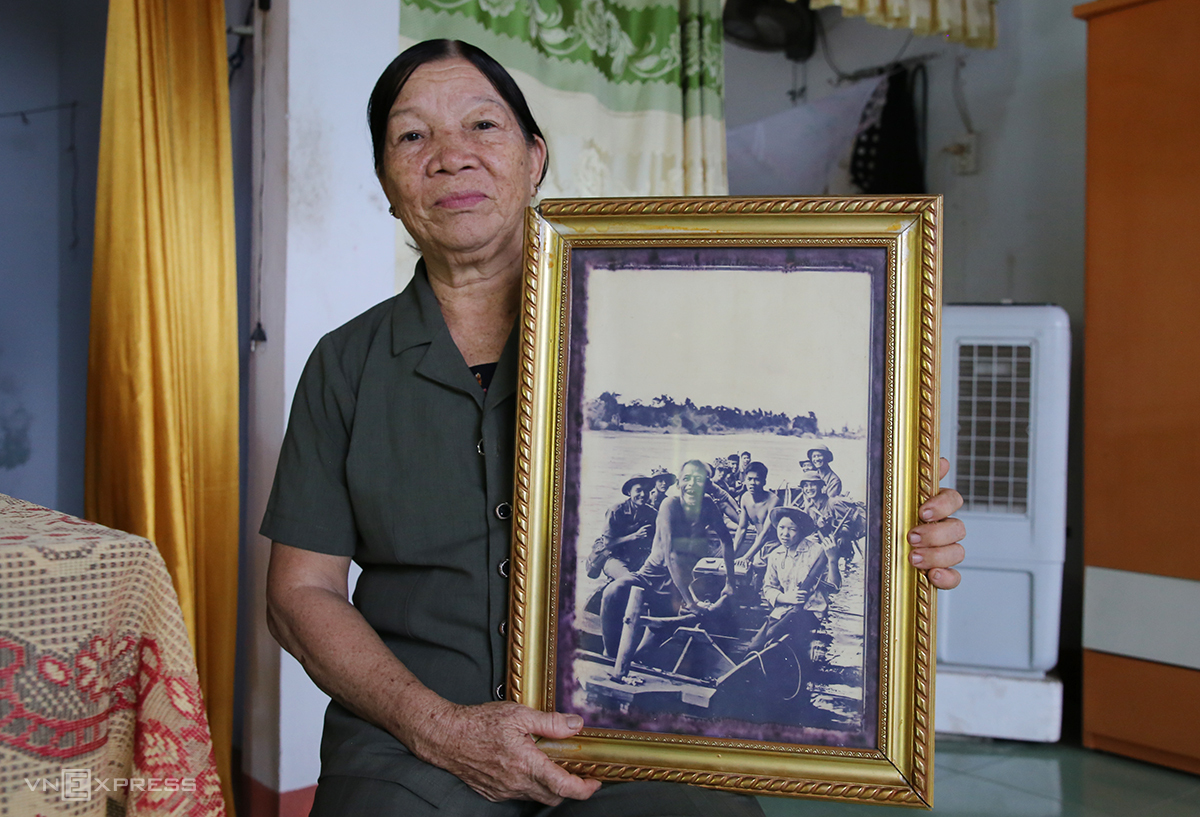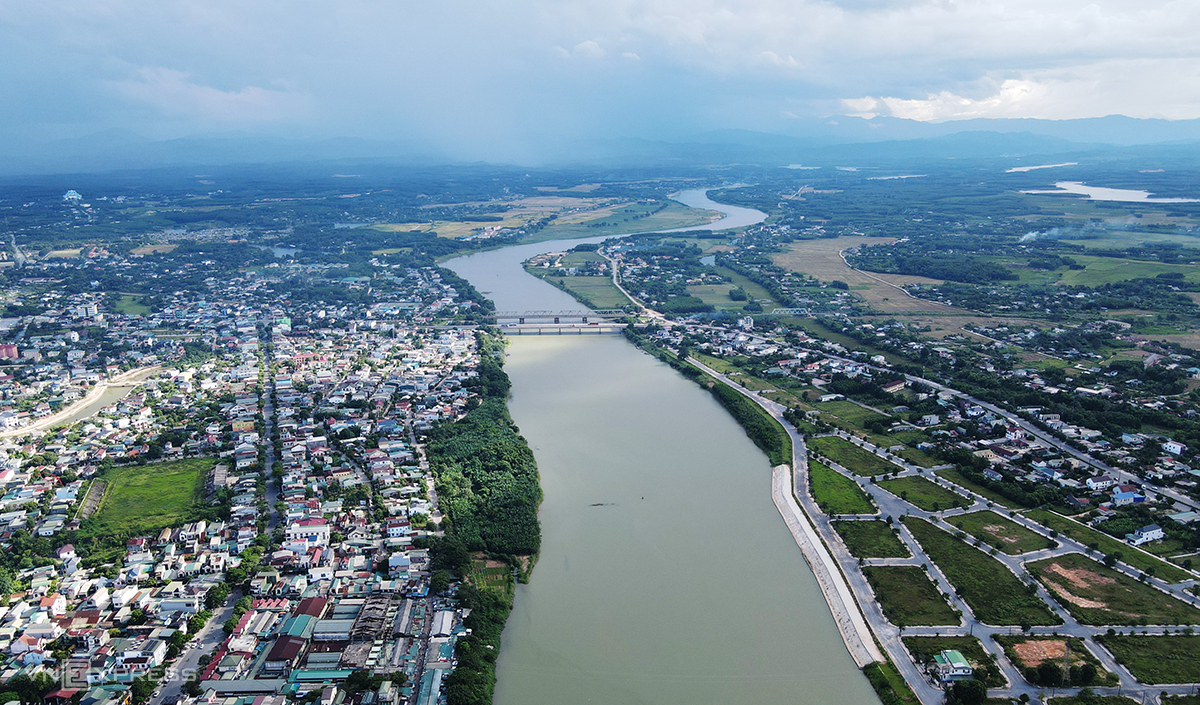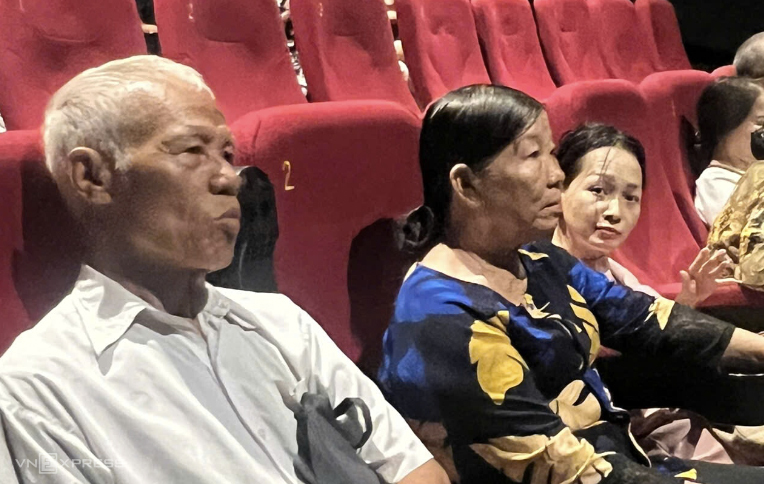Since the recent premiere of the film "Red Rain", 71-year-old Nguyen Thi Thu, from Trieu Phong commune, has received many visitors. She is the inspiration for the character O Hong, the ferrywoman who transported soldiers across the Thach Han River. In her modest home in Trieu Phong commune, she recounted her life intertwined with those river crossings.
Thu lived with her parents and three brothers in the former Trieu Giang commune, part of the liberated zone. After the Geneva Accords were signed on 20/7/1954, the 17th parallel became the temporary dividing line between North and South Vietnam. The area of Quang Tri north of the Ben Hai River was liberated, while the area south of the river (including Quang Tri town) remained under the control of the US and the Republic of Vietnam government.
During two offensives in the spring-summer campaign of 1972, by 1/5/1972, the People's Army of Vietnam (PAVN) gained complete control of Quang Tri province. Having lost this strategic base and facing the potential loss of Thua Thien province, which threatened to derail the Vietnamization policy, the US reinforced the Army of the Republic of Vietnam (ARVN) to recapture Quang Tri, especially the citadel. The citadel held significant political and diplomatic importance, symbolizing each side's resolve.
On the morning of 28/6/1972, the ARVN, backed by the US, launched a counteroffensive codenamed "Lam Son 72" to retake Quang Tri, beginning 81 days and nights of bombardment of the citadel area. Their objective was to raise their flag over the citadel by 10/7, three days before the scheduled Paris Peace Talks, to gain leverage in the negotiations.
 |
Thu with a photo taken by journalist Doan Cong Tinh of her and her father ferrying soldiers across the Thach Han River in 1972. Photo: Dac Thanh |
Thu with a photo taken by journalist Doan Cong Tinh of her and her father ferrying soldiers across the Thach Han River in 1972. Photo: Dac Thanh
Under constant bombardment, the population scattered, some fleeing south, others north. Thu’s parents evacuated to (the former) Quang Binh, while her three brothers went south. Thu remained, joining the local guerrilla forces. In 1971, at 17, she was engaged to Nguyen Cau, a clam digger on the Thach Han River. Her fiance fled south and was conscripted into the ARVN in Da Nang.
Although not yet formally married, Thu was considered a daughter-in-law and moved in with her father-in-law, Nguyen Con, in Giang Hien village, on the banks of the Thach Han River, about two kilometers from the citadel. Every day, Con used his motorized wooden boat to dig for clams. When the Quang Tri Citadel became the focal point of the war, Con volunteered to ferry soldiers across the Thach Han River to the citadel.
The Thach Han River was the only route connecting the rear with the battlefield at the citadel. From Thach Han Bridge down to the citadel, a distance of about 1.5 km, the river was shallow in the summer, with stretches where soldiers could wade or swim short distances. Further downstream, the river became deeper and wider, requiring boats for crossing. "Seeing the young, bookish soldiers arriving from the North, many of whom were probably unfamiliar with the river and carrying heavy gear, my father volunteered to ferry them across," Thu explained.
Braving bombs and shells to transport soldiers
Every day, Thu witnessed her father-in-law and others ferrying soldiers from the north to the south bank of the Thach Han River and transporting the wounded back to the rear. Meanwhile, B-52 bombers continually dropped their payload, creating dense smoke, and offshore artillery relentlessly shelled the area. Worried about her father-in-law navigating the river alone, Thu asked to assist him. "Back then, only men piloted motorboats. No girl my age volunteered like I did," Thu recalled.
Soldiers gathered near Thu’s house, awaiting departure orders. As the boat left the shore, she sat at the bow, watching for attacking aircraft and artillery fire. Whenever a B-52 appeared, trailing its telltale smoke plume, she alerted her father-in-law to quickly head for shore. Nearing the south bank near the citadel, Con cut the engine, and Thu dipped the oar, letting the current carry the boat to the bank, allowing the soldiers to disembark easily. On the return trip, carrying the wounded, they navigated the boat gently to minimize jostling and further injury.
During the 81-day battle, Quang Tri town was almost completely leveled, with only Bo De School still standing. As the enemy focused their attacks during the day, crossing the river then risked detection, so for many days, they had to wait for nightfall. However, at night, the enemy deployed parachute flares, each burning for about two hours, illuminating the area, forcing them to find ways to avoid detection. "Sometimes, when the enemy bombed, we had to hold the rudder steady, waiting for the waves to subside before continuing. I held my rifle while paddling, trying to stay calm to prevent capsizing," she remembered.
 |
The Thach Han River as it flows past the Quang Tri Citadel. Photo: Dac Thanh |
The Thach Han River as it flows past the Quang Tri Citadel. Photo: Dac Thanh
During the rainy season, the Thach Han River swelled, its currents shifting hourly. Those unfamiliar with the river could easily be swept away, but Thu's father-in-law, a lifelong riverman, knew every bend and sandbar. He taught her how to maneuver the oar at the bow for safety. Each day, they made 5 to 10 trips, each carrying 10 people, with dozens of trips on peak days. The boat didn't operate on a fixed route but traveled to various points along the river.
Several times, while crossing the river, the boat came under enemy fire. The soldiers would lie on top of Thu and her father-in-law to shield them. "The soldiers cared deeply for us. Each time we neared the shore, they would jump out to hold the boat, not letting me do it," she recounted. Once, as the boat nearly reached the other side, enemy aircraft appeared. Thu jumped into the water just as the bombs hit. The blast knocked her unconscious, leaving her with lingering headaches to this day.
Despite her age and fading memory, Thu says she will never forget the gentle smiles and waves of the young men before they headed into battle, or the wounded who died before reaching medical care. "I vividly remember one instance when, nearing the north bank, a critically injured soldier cried out, 'Mother! Mother!' before passing away before reaching the field hospital," she recalled.
Spending most of their time ferrying soldiers, they couldn't dig for clams, yet Thu and her father-in-law never went hungry. They survived on rice abandoned by fleeing villagers and on soldiers' rations. The army provided fuel for the boat’s engine. "Fortunately, throughout the war, the boat remained undamaged. My father-in-law remained healthy and was able to pilot the boat day and night, ensuring uninterrupted transport for the troops," she said.
Thu recounts ferrying soldiers across the river with her father. Video: Dac Thanh
According to the Quang Tri Citadel Museum, the total tonnage of bombs and shells dropped by the US and ARVN forces on the citadel and Quang Tri town (an area of over 3 km2) during the 81-day siege was equivalent to the explosive power of 7 atomic bombs. This included 328,000 tons of bombs, 552,000 105 mm shells, 55,000 155 mm shells, and 8,164 175 mm shells. US naval artillery fired 615,164 rounds, US aircraft conducted 1,650 bombing raids, and ARVN aircraft carried out 594 raids.
Speaking about the ferocity of the fighting at the citadel, Major General Nguyen Duc Huy, former Deputy Commander of Military Region 2, who served as Deputy Commander of the 9th Regiment, 304th Division, told VnExpress that it’s hard to recall the most intense attack, because during all 24 hours of those 81 days, "the enemy was constantly attacking fiercely." "Our losses were immense, and the full extent has yet to be fully documented. On average, we lost a company each day and night, about 100 men," he said.
Life in peacetime
On 16/9/1972, the troops withdrew from the citadel, ending the 81-day battle. Thu continued her service with the local guerrilla forces. Her father-in-law returned to his life as a clam digger. In 1975, with peace restored, Thu was offered three months of literacy classes, but due to her age, she struggled to learn and remains illiterate. Nguyen Cau survived the war and returned home. After a period of re-education, they were married.
In 1978, Thu’s father-in-law passed away due to illness. Thu and her husband continued clam digging on the Thach Han River to support their four children. "People often ask why I haven't applied for government benefits. I tell them that being alive is a blessing. The war left thousands dead in the Thach Han River and buried in the soil of Quang Tri town," she shared. In 2024, she began receiving benefits as a guerrilla fighter exposed to Agent Orange, amounting to 2.1 million VND per month.
"Red Rain" premiered, but due to her health and the distance, Thu hadn't seen the film, despite being told she was the inspiration for the character O Hong. On the afternoon of 9/9, she and her husband were taken to a cinema about 10 km from their home. "Watching scenes of soldiers drowning in the river, some buried in the mud, brought back memories. I trembled," she said.
 |
Thu and her husband watching "Red Rain" on the afternoon of 9/9 at the cinema. Photo: Minh Anh |
Thu and her husband watching "Red Rain" on the afternoon of 9/9 at the cinema. Photo: Minh Anh
Thu finds joy in occasionally meeting veterans of the battle for Quang Tri Citadel. At the end of 1992, a veteran visited her home, introducing himself as Pham Van Hung, from Thai Nguyen. "After years of searching, I've finally found the father and daughter who ferried us across the river," Thu recalled the veteran saying. Thu herself doesn’t recall how many times she transported soldiers, nor does she remember their faces. Each crossing was hurried, with little time for conversation.
In 2007, commemorating the 35th anniversary of the battle for the citadel, photojournalist Doan Cong Tinh printed and presented Thu with a photo he had taken of her and her father-in-law. The 1972 photo, titled "Fisherman and daughter from Trieu Phong ferrying soldiers and weapons to the citadel," shows Nguyen Con steering the motorboat, smiling and revealing his blackened teeth, his daughter-in-law beside him holding a rifle, and 10 PAVN soldiers smiling in the background. The framed photo now hangs prominently in her home.
Dang Si Dung, Chairman of Trieu Phong commune, says the photo of Thu and her father-in-law, like the character O Hong in "Red Rain", embodies the resilience of the people of Quang Tri during the battle for the citadel. At that time, in the area north of the Thach Han River, including the former communes of Trieu Thanh, Trieu Thuong, Trieu Giang, and Trieu Ai, residents joined the militia and guerrilla forces. In addition to fighting, they ferried soldiers, weapons, and food across the river, returning with the wounded and the dead for treatment and burial. Many ferrymen died while performing their duties.
Dac Thanh












